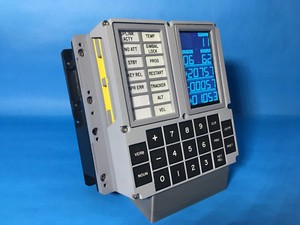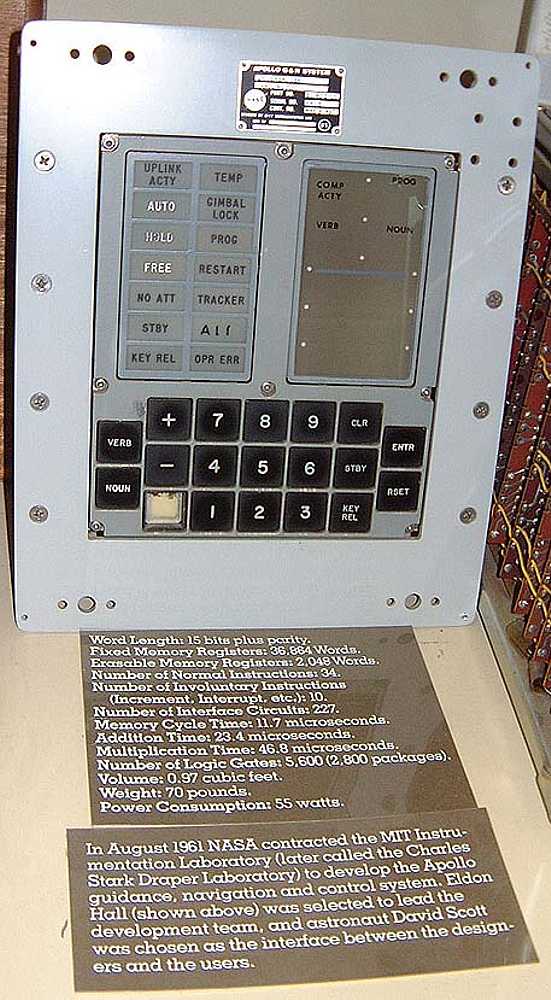

- #APOLLO GUIDANCE COMPUTER SERIAL#
- #APOLLO GUIDANCE COMPUTER FULL#
- #APOLLO GUIDANCE COMPUTER SOFTWARE#
A single precision word of data consisted of 14 bits, with the other 2 bits as a sign bit (with a one indicating negative) and a parity bit (odd parity). Advantages of a shorter word are simpler circuits and higher speeds, and greater precision could be obtained by using multiple words 38. MIT considered the following factors in deciding the word length: (a) precision desired for navigation variables, (b) range of input variables, and (c) the instruction word format 37. Many scientific computers of the time used 24-bit or longer word lengths and, in general, the longer the word the better the precision of the calculations. The choice of a 1 6-bit word size was a careful one. As well as the DSKYs, the computer directly hooked to the inertial measurement unit and, in the CM, to the optical units. The DSKYs were 8 by 8 by 7 inches and weighed 17.5 pounds.

In addition, a "mark" button was at the navigator's station to signal the computer when a star fix was being taken. Two DSKYs were in the CM, one on the main control panel and one near the optical instruments at the navigator's station. Crew members could communicate with either computer using display and keyboard units (DSKY, pronounced "disky"). The machine in the lunar module was identical. Block II measured 24 by 12.5 by 6 inches, weighed 70.1 pounds, and required 70 watts at 28 volts DC. The CM housed the computer in a lower equipment bay, near the navigator's station. Chapter Two - Computers On Board The Apollo Spacecraft - The Apollo guidance computer: Hardware The Apollo Guidance Computer was fairly compact for a computer of its time.
#APOLLO GUIDANCE COMPUTER SOFTWARE#
When MoonJS simulation software is running on the computer, the DSKY functions like the real deal.Computers in Spaceflight: The NASAExperience
#APOLLO GUIDANCE COMPUTER SERIAL#
The Mega also appears as a virtual serial port when plugged into a computer. A pair of Arduino Nano boards control the two LCDs, while an Arduino Mega handles the keyboard. Below those are the same 19 buttons as the real DSKY. It has a couple 2.8″ 240 x 320 pixel LCD screens that mimic the DSKY’s displays. The Dual Screen Apollo DSKY simulator replicates all of that behavior when connected to a modern computer, which acts as the Apollo Guidance Computer. The right display had numerical readouts for the program number, verb, and noun, as well as data and a computer activity status light. The left display had several indicator lights, similar to your car’s dashboard, to show the statuses and warnings. It had 19 buttons, including a numerical pad, situated below two displays.

The actual Apollo Guidance Computer sat inside of a protective metal enclosure that was rather boring, but the DSKY (Display and Keyboard) interface, which acted like a terminal, had a very distinctive design. That’s why a maker used three Arduino boards to create a simulator. But reading that fact isn’t the same as actually experiencing the Apollo Guidance Computer for yourself. For example, the Apollo Guidance Computer, which handled navigation and control for both the Apollo Command Module and the Apollo Lunar Module, ran with less RAM and processing power than a TI-83 graphing calculator.
#APOLLO GUIDANCE COMPUTER FULL#
NASA’s history is full of fascinating facts and trivia.


 0 kommentar(er)
0 kommentar(er)
